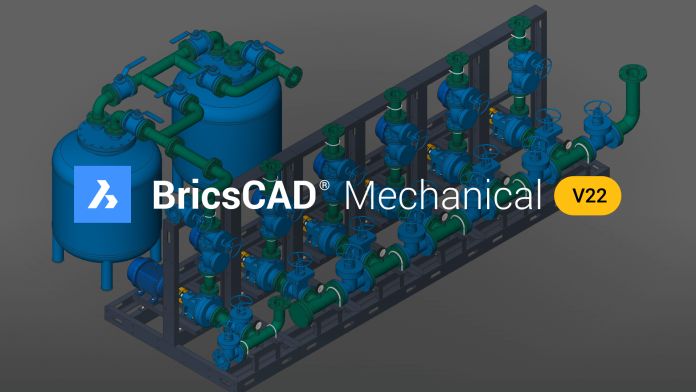Bricsys has announced the launch of BricsCAD® Mechanical V22, a mechanical design solution with smart functionality, workflows, and approaches to optimise the design-to-manufacture process
Whilst the core BricsCAD platform can address a wide range of design needs such as product development in 2D or 3D, BricsCAD Mechanical design solution caters to manufacturers with more advanced requirements, such as complex assemblies, sheet metal, and piping design.
V22 delivers enhancements to BricsCAD Mechanical’s unique variational 3D modelling capability – enabling fast and accurate design from concept to detail, and improvements to BricsCAD Mechanical’s powerful multi-CAD import workflows.
The introduction of a unique, automated one-step solid-to-sheet metal process facilitates faster development of sheet metal components.
For those developing mechanical products in the context of a building, BricsCAD Mechanical unites manufacturing with BIM and Point Cloud scans in a way that is unlike any other solution.
BricsCAD users have the flexibility to choose their design approach – bottom-up, as parametric catalogue items, or top-down, as custom-made products.
Dmitry Ushakov, BricsCAD mechanical product owner, stated: “Our mission is to help manufacturers create products quickly and flexibly, with the limited resources they have.
“We’ve developed our technology to make design accessible to all manufacturers, by providing all the tools designers need, in a familiar user interface, and at a reasonable price point.”
Assembly design, validation, and BOM creation
BricsCAD Mechanical design solutions provides powerful tools that deliver simple and fast assembly design and modifications.
Custom properties, such as ‘manufacturer name’ or ‘delivery date’ can now be added to components in an assembly, improving downstream understanding of the product’s design.
Cost roll-ups and manufacturing planning efficiencies can be better realised by incorporating these custom properties into a product’s Bill of Materials (BOM).
A new approach to creating and using Mechanical Blocks in V22 enables flexibility and speed in building assemblies.
These components can now be defined from Blocks, external references (XREFs) or 3D solids.
With BricsCAD V22, piping design is more intelligent, with an automated tool that converts BIM flow segments and fittings into mechanical assemblies, composed of standard piping parts.
These automatically created assemblies support a top-down workflow for pipe design. A variety of standard valves has been added to the Mechanical Library for use in piping design workflows.
Automatically generated bolted connections insert the proper number of fasteners, and update automatically with one click when pipe size, rating, or other specification change.
Bills of materials also generated automatically, now include thumbnail images for visual clues of each component within an assembly.
Sheet Metal design
Mechanical design is not just about assemblies – it is also about creating parts within them.
BricsCAD Mechanical uses the power of BricsCAD Pro and 3D design techniques to provide an intelligent, powerful means of developing component parts.
The software offers powerful and unique functions for sheet metal design, and its features are particularly adapted for interactive communication between stakeholders involved in the manufacturing process.
Manufacturing projects typically come together from multiple design sources, including partner offices that use other CAD products. BricsCAD Mechanical can simplify the re-work necessary to bring in sheet metal components created in any CAD system, quickly and with no loss of accuracy.
2D drawing and documentation
BricsCAD Mechanical can quickly generate accurate 2D drawing views of 3D assemblies and parts, sheet metal flat patterns, and BOMs, and offers a host of efficient tools to detail, dimensions and annotate these critical manufacturing drawings.
These tools have been evolved even further in BricsCAD Mechanical V22.
V22 sees numerous improvements to accelerate the creation of drawing views, and improve view and detailing accuracy, enabling users to make their 2D layouts more precise, reducing the risk of downstream errors.
A new hidden-line removal engine improves accuracy when generating views of, for example, spline geometry, and isometric view dimensions now reflect the actual, true 3D size of the detailed geometry.
Automatic generation of interference edges at the intersection of multiple solid bodies is another enhancement designed to improve drawing accuracy and the quality of 2D layouts.
Increased compatibility with AutoCAD® Mechanical detailing features enables an even smoother path for legacy CAD system users to upgrade to BricsCAD Mechanical V22.
Find out more about BricsCAD Mechanical here.














